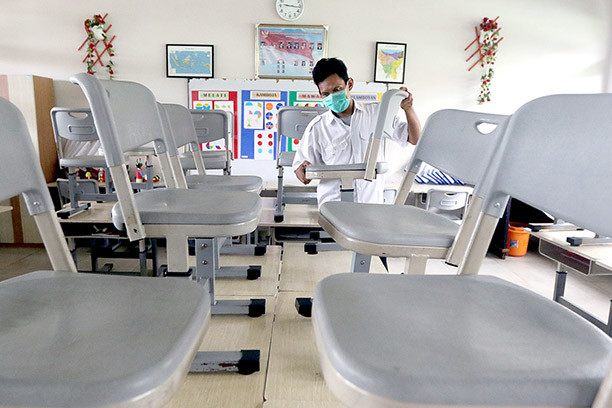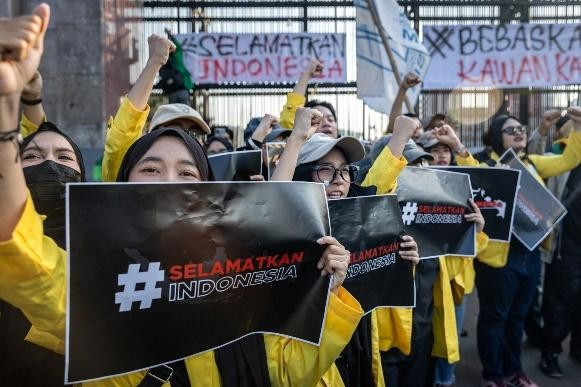Popular Reads
Top Results
Can't find what you're looking for?
View all search resultsPopular Reads
Top Results
Can't find what you're looking for?
View all search resultsSchool reopening faces safety dilemma
With only 6 percent of the total schools and madrasas reopening when the new academic year begins in July, most schools have to make do with no internet connectivity.
Change text size
Gift Premium Articles
to Anyone
T
he closure of schools due to COVID-19 in March was an urgent measure to protect both learners and educators while allowing education to continue. Since then, the closure has affected 646,000 schools and madrasas, shifting 62 million students and 3.1 million teachers to remote learning, according to data from the National Secretariat for School Safety (Seknas).
The Indonesian Pediatrics Association (IDAI) found that as of May, 3,324 boys and girls were patients under monitoring and 584 had been infected with COVID-19. The pandemic has inflicted additional burdens on children who have been dealing with malnutrition, high rates of pneumonia and a lack of proper handwashing facilities in schools (United Nations Children’s Fund, 2020).
Further to the joint decision of four ministries on the new academic year, which includes a procedure to reopen schools based on risk zones, mandatory approval of local authorities, parental consent and school-reopening checklists, it is high time to look back at the factual challenges to remote learning.
First, the digital divide has disrupted quality education for boys and girls in remote places. Seknas data show 31.8 percent of students have no access to the internet and 7.1 percent of them do not even have access to electricity. With only 6 percent of the total schools and madrasas reopening when the new academic year begins in July, most schools have to make do with no internet connectivity.
Second, school communities have yet to find an evaluation modality to understand the efficacy of home learning and the authorities need to define flexible student assessments during the transition period.
Third, psychosocial distress experienced by teachers, caregivers and students must continuously be addressed; and last, the right to education of children with disabilities and in temporary shelters has only received minimal attention.
As a global safe school leader, Indonesia is committed to a comprehensive school safety framework (CSSF) and has been a strong proponent of the ASEAN Safe Schools Initiative. The CSSF aims for the protection of learners and educators, plans for education continuity, the safeguarding of education investment and resilience strengthening with three pillars: safe learning facilities, school disaster management and risk reduction and resilience education.
The pandemic, seemingly estranged from the conventional notion of disasters, is viewed as a hazard. Based on Law No. 24/2007 on disaster management, a pandemic is categorized under non-natural hazards and the CSSF advocates a school multi-hazard assessment with a multi-sectoral approach.
The mindset of multi-risks should be embedded across the three pillars: conducting structural assessment and risk mitigation; developing school disaster-management plans and drills; and integrating resilience education in the intracurricular and extracurricular activities.
As for safe learning facilities, we need to prioritize the availability of water and sanitation, including inclusive, gender-sensitive toilets and handwashing stations, disinfected school buildings, masks and gloves and other protective gear. In the post-recovery phase, a structural assessment should identify how school infrastructure can control communicable diseases with proper ventilation and hygiene and the cleaning of the entire school premises.
Pillar two addresses the school-based risk assessment and education continuity plan. When a pandemic re-emerges, schools will be better able to cope with it. The standard operating procedures should include staggered school shifts, regular health checks and absenteeism monitoring, building the referral system to health care in the community, hygiene promotion and capacity building, social distancing and psychosocial support. The healthcare or first aid skills of the school community need to be enhanced.
Meanwhile, to promote resilient education, schools can adopt age, gender and disability-appropriate learning with online and printed communication materials and dissemination through intra or extracurricular activities. It is recommended that feedback is collected from children and the school community on the appropriate methodology to be adopted if infection cases resurge: with online, offline or blended learning.
Moving forward, it is important to heed these following suggestions: First, before and during the school reopening, the protection and safety of the entire school community will always take precedence. The mapping of risk zones and guides on school safety should be widely introduced and strictly adhered to with a mechanism in place to consult with and receive feedback from schools.
Second, as the health crisis hits different dimensions of children’s welfare, key actors need to take into consideration children’s nutritional intake, the prevention of stigmatization of children suspected of COVID-19 infection, children’s participation in risk communication, psychosocial support and the needs of marginalized children: those with disabilities, living in temporary shelters and in poverty.
Third, the government needs to prepare itself with a plan for a curriculum adjustment and make-up classes for students who experience learning setbacks.
Finally, multi-stakeholder engagement and public-private partnerships to address different dimensions surrounding school safety continue to be promoted.
All these should build up to the importance of investment in school disaster-risk reduction and the resilience of the education system to cope with multiple hazards. It requires the long-term commitment of all key actors so that if a crisis occurs, and a pandemic is one such, the education system will quickly bounce back to maintain children’s educational development.
***
Wahyu Kuncoro has been a humanitarian worker and practitioner in disaster risk reduction in the education sector and education in emergencies for the last 15 years. Renar Berandi is regional disaster risk reduction specialist at Plan International Asia Pacific Hub, based in Yayasan Plan International Indonesia.










